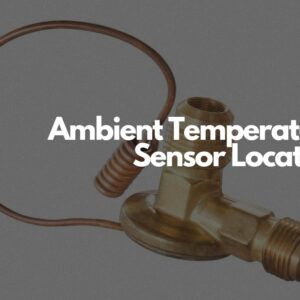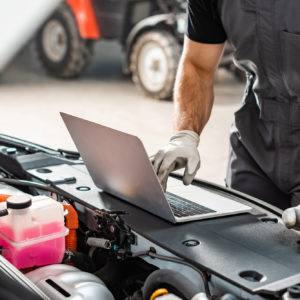People often say, “A craftsman is only as good as his tools,” so it’s no wonder why mechanics and gearheads alike invest in a handheld temperature gun of their own.
If you’re a big fan of DIY repairs or just enjoy tinkering with your vehicle, then why not add a temp gun to your own toolbox?
What Is a Handheld Temperature Gun?
Also known as non-contact temperature readers, handheld temperature guns are digital tools that can read an object’s surface temperature within seconds.
They’re a lot like thermometers, but they work even without coming into contact with the object. All you have to do is point the temp gun at an object or surface, and the screen should display the temperature reading after a few seconds.
How Does a Temperature Gun Work?
If you activate your temperature gun, you’ll notice it triggers a laser. This laser helps you aim the thermometer at a specific area while reading its temperature.
Most temp guns come with a lens that measures an object or surface area’s infrared energy, which is then converted into a temperature reading that shows up on the display screen within seconds.

What Are Some Common Uses of a Temp Gun?
Temperature guns only have one primary function, so how exactly are they so versatile? Well, you’d be surprised by just how many things you need to measure the temperature of. Here are some examples:
Around the Garage
Both mechanics and gearheads know just how important temp guns are in the garage. Here are some ways you can use a temp gun when tinkering with your vehicle:
- Measure the individual cylinder exhaust temperature
- Test for blockages in the radiator by shooting the gun all over the coils of the radiator and looking for cold spots
- Measure your vehicle’s belt and pulley temperatures
- Look at the temperature of brake rotors from side to side to see if your brakes are staying engaged
- Check the inlet and outlet temperature of a catalytic converter to see if it’s working
- Inspect the temperatures of your heating, ventilation, and air conditioning (HVAC) system’s inlets, outlets, supply lines, and more
Some also suggest using a temperature gun to check the coolant temperature, but doing so can be misleading. Like checking heater hoses for a blockage in the heater core, you may measure with a gun and get a certain result. But in reality, you may be better off grabbing one hose to make sure it’s hot and the other is warm, indicating that coolant is flowing. If the inlet is hot and the outlet is cool, then you have a restricted heater core, but the temperature gun may not show that. Also, the upper radiator hose and lower hose should be very hot to the touch. If it’s cool then, the thermostat may have an issue, and the gun may not show that.
Of course, these aren’t the only ways you can use a temp gun in the garage. Feel free to browse your temperature gun’s manual for more information.
At the Race Track
Did you know handheld temp guns are very useful for racers too? Here are some of the ways racers use temp guns:
- Check the tire temperature after burnout at the drag strip
- Conduct a tire temp test across the face for adjusting air pressure or camber angle at the autocross
- Track the tire’s surface temperature at the autocross or during drag racing
Having a temperature gun at hand can help you monitor your tires much more efficiently at the race track.
In an Industrial Shop
If you work at an industrial shop, you no doubt have a couple of temp guns lying around. Here are a couple of ways you can use them:
- Check the oven temperature before powder coating
- Verify the temperature of micrometers for measurement accuracy
With a temperature gun, you can easily double-check the temperature of the oven and other equipment to make sure the entire process goes smoothly.
How To Use Handheld Temperature Guns
Specific instructions vary depending on the brand and model of your temperature gun, but they’re pretty simple: just point and click. Pull the trigger to activate the temperature gun and aim the red laser beam at the object you want to measure.
Most temperature guns are battery-operated, and in most cases, they typically come with a free battery in the packaging.
Some also come with adjustable settings, such as choosing between Fahrenheit or Celsius, holding the reading on the display, and showing a minimum and maximum temperature range.
Things To Consider When Choosing a Temperature Gun
With how useful temp guns are, it’s no wonder you’re thinking of buying one for yourself too. Here are some factors to consider when choosing the right temperature gun:
Accuracy
Are temperature guns accurate? Well, not all the time. An infrared temp gun’s accuracy largely depends on its distance-to-spot (D/S) ratio, which refers to the maximum distance the gun can measure a specific object.
If you need to measure objects from a farther distance, then consider getting a temp gun with a bigger D/S ratio.
Emissivity
Some temperature guns don’t hold up against highly reflective surfaces like the top of an aluminum radiator. This is because objects with highly reflective surfaces tend to have lower emissivity levels than non-reflective surfaces.
Emissivity refers to an object’s ability to emit infrared energy. If you often work on objects made of aluminum or other reflective material, then consider going for a temp gun that comes with an adjustable emissivity level.
Temperature Range
Did you know different temperature guns come with different temperature ranges? Some temp guns have a wider range than others, but that doesn’t necessarily mean they’re better.
Temp guns with a narrow temperature range are often the better choice if you need higher resolutions to help you monitor the temperature of a specific process.
Reading Speed
When it comes to objects that heat up quickly or are constantly moving, a temp gun with a fast reading speed makes all the difference. Go for temperature guns that can deliver an accurate reading after a few seconds of pulling the trigger.
Design
Does your temp gun of choice come with a backlit display, protective carrying case, and durable shell? You’ll be using your temp gun a lot in the garage, so make sure you go for the one with a practical design.
Warranty
Temperature guns are often exposed to harsh heat, which means they might not always hold up for too long. That’s where a manufacturer’s warranty comes in handy.
Before sealing the deal, check if your chosen temp gun comes with a warranty. If it doesn’t, then you might want to consider some options with a warranty, even if they might be more expensive.
Any information provided on this Website is for informational purposes only and is not intended to replace consultation with a professional mechanic. The accuracy and timeliness of the information may change from the time of publication.




















